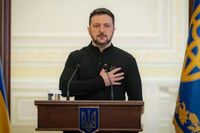On April 17, 2025, the ongoing conflict between Ukraine and Russia saw significant escalations, marked by a series of drone attacks and political developments that could shape the future of the war. In a grim reminder of the continuing violence, a Russian drone strike on the city of Dnipro late on April 16 resulted in the deaths of three individuals, including a young girl, and injured 28 others. The State Emergency Service of Ukraine confirmed that the attack ignited several fires across the city, which have since been extinguished.
Regional governor Sergiy Lysak reported that among the deceased were both a young girl and an elderly woman, highlighting the tragic toll of the violence. This drone strike came just days after a ballistic missile attack on the city of Sumy killed at least 35 people and injured over 100, marking it as one of the deadliest assaults on Ukrainian civilians this year.
As the conflict intensifies, the Russian Ministry of Defence announced the destruction of 71 Ukrainian drones across six regions in Russia overnight, with a significant number intercepted in Kursk. This military escalation occurs despite ongoing discussions about a potential ceasefire. U.S. President Donald Trump has been actively seeking a diplomatic resolution, dispatching his peace envoy Steve Witkoff and Secretary of State Marco Rubio to Paris for talks with European leaders, including French President Emmanuel Macron.
In a related development, Ukrainian President Volodymyr Zelensky stated that negotiations with the U.S. regarding a minerals deal are progressing rapidly. He emphasized that the basic legal framework is nearly finalized, which would allow the U.S. to access Ukraine's rich natural resources. This agreement is seen as a way to recover some of the billions the U.S. has spent on military aid to Ukraine since the onset of the invasion.
Zelensky's optimism was echoed by first deputy prime minister Yulia Svyrydenko, who noted that both sides have worked diligently to draft the agreement, which is expected to yield economic benefits for both nations. However, the discussions have been complicated by Ukraine's insistence that it will not recognize past U.S. military aid as a debt.
Meanwhile, the ongoing violence has not relented. Just hours before the announcement of the minerals deal progress, Russian forces launched a drone attack on Odesa, injuring three people and damaging several residential buildings and infrastructure. The attack sparked fires in the Black Sea port city, further underscoring the dire humanitarian situation in Ukraine.
In response to the escalating violence, Ukraine's parliament voted overwhelmingly to extend martial law until August 6, 2025. This decision reflects the government's commitment to maintaining national security amid the ongoing conflict.
On the diplomatic front, the Kremlin has expressed a willingness to engage in further discussions with the U.S. regarding a potential peace deal, although no clear outline has yet been established. Kremlin spokesperson Dmitry Peskov noted that while the talks have been constructive, a definitive timeline for an agreement remains uncertain.
As the situation unfolds, the international community continues to call for a ceasefire to halt the violence and address the humanitarian crisis. The U.S. and its allies are closely monitoring the developments, with hopes that diplomatic efforts will yield a resolution to the conflict.
In summary, the situation in Ukraine remains precarious, with continued military actions and diplomatic negotiations occurring simultaneously. The humanitarian impact of the conflict is profound, as civilians bear the brunt of the violence. As talks progress regarding a minerals deal and potential ceasefire, the hope for peace remains a distant yet essential goal.





